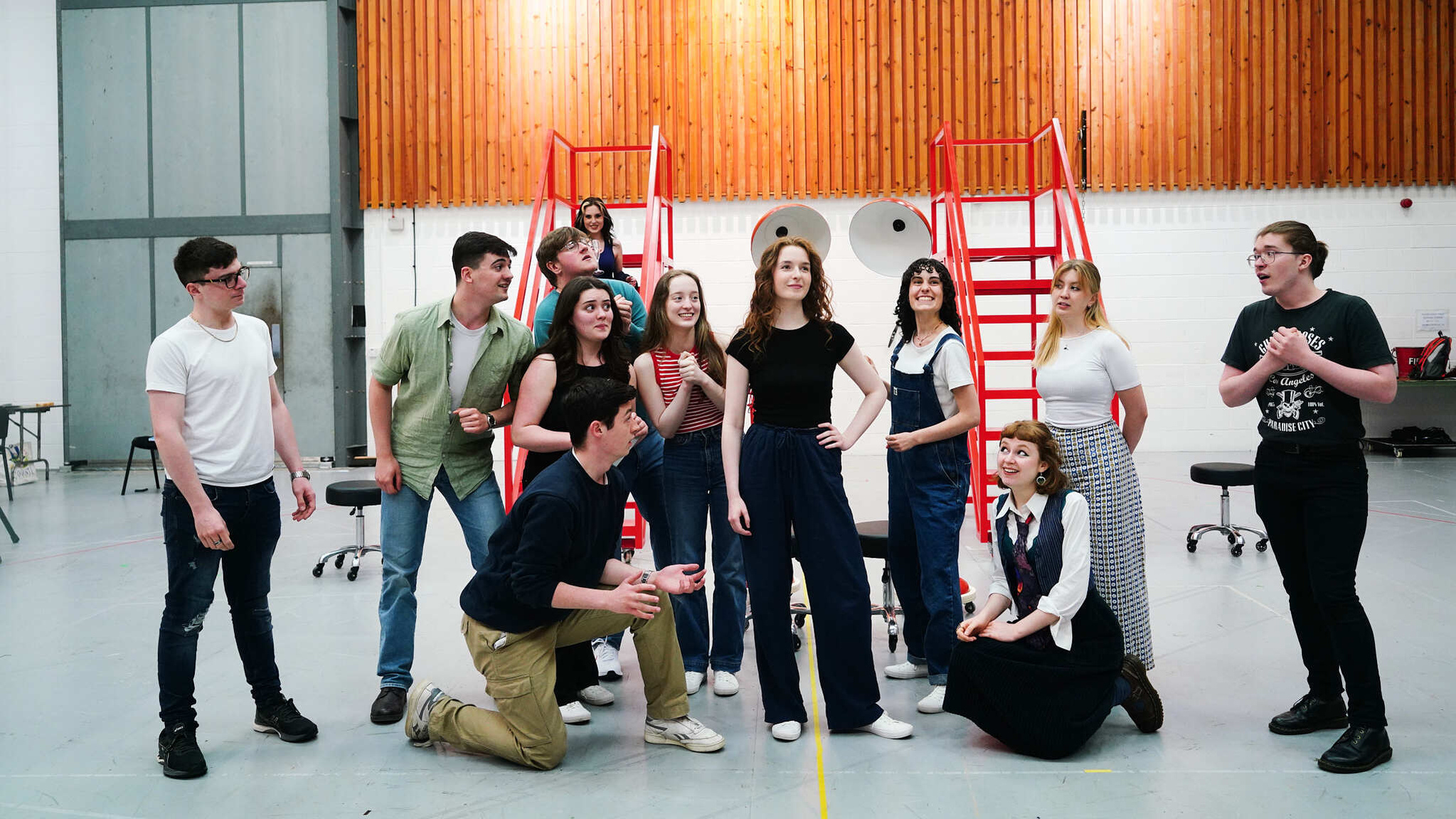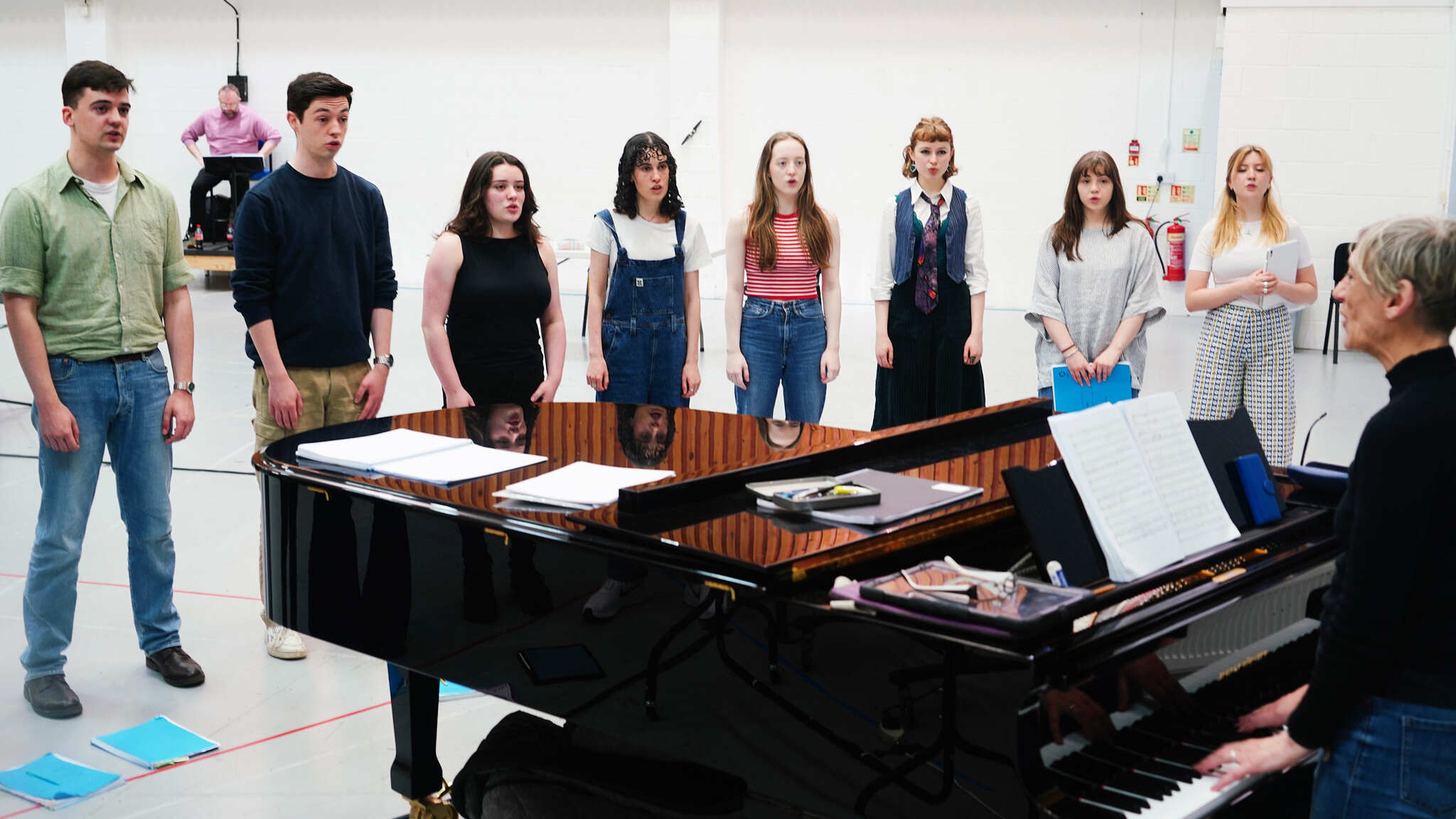World premieres have featured prominently in the repertoires of Scottish Opera Young Company and its predecessor CONNECT: seven in total between 2009-2024. This summer’s new opera – RED, with music by Karen MacIver and words by Jane Davidson MBE, Scottish Opera’s Director of Outreach & Education – is based on four fairy tales woven together to explore the cyclical stages of one woman’s life and the archetypal struggles and triumphs marking each. The show promises a darkly comedic, magical realist take on tales first encountered in childhood.  Scottish Opera Young Company members during rehearsals for RED. Credit Ruby Pluhar.
Scottish Opera Young Company members during rehearsals for RED. Credit Ruby Pluhar.
RED began as four standalone pieces written for Young Company workshop weekends to improve sight-reading skills. ‘Chris [Gray, SOYC Artistic Director] wanted it to be challenging,’ says Jane. The united four-part story of the full piece has its own goal: finding universality in centuries-old stories. Both Jane and Karen love magical realism – a genre blending real and fantasy elements to build a familiar but surprising world. ‘Opera is a fantasy world, a heightened reality because of the art form – suddenly crockery speaks and hair grows,’ says Jane. After extensive research through the work of The Brothers Grimm, they found women’s lives and roles divided into four roles, giving the show its structure.
Recognisability played into the stories the pair picked. ‘We want to give the audience a gradual realisation,’ says Jane. ‘RED directly alludes to Red Riding Hood, so we’ll give you that one for free.’ The other sections, inspired by aspects of Hansel and Gretel, Rapunzel, and Snow White, will unfold for audiences. What Jane and Karen hope is that these tales have never been encountered quite like this.
‘We can use shortcuts and be surreal while still being honest,’ Karen says. ‘Hopefully the audience will not feel lost in the story as it’s rooted in knowledge from childhood. You could take these stories and pull them like an elastic band, and people will still understand.’ By making the protagonist one person, Karen hopes RED hints at ‘the universal story’ seen across cultures and codified by theorist and author Joseph Campbell in The Hero With A Thousand Faces.
The pair struggled to find the final story with an old woman as the protagonist (an issue still seen today in film and theatre), so some creative adaptations have been made. Likewise, some stories examined were fascinating, but not well-known enough for RED. ‘We looked at masses and masses of stories,’ says Jane. ‘Some are just two paragraphs long. There was a really interesting, horrifying one: a group of village kids are playing, and one is hit on the back of the head and killed. It was not an accident. The children decided he was to be the victim, so it is more complex. The village has to decide whether or not the children should be tried for murder. What’s the age of responsibility?’ Such tales were often ‘for’ children, or for mothers and carers to tell children, but they originate from a time when ‘childhood’ was not as protected as it is today. Jane notes that the Grimms gathered many stories from their women friends and relatives. 
Scottish Opera Young Company members during rehearsals for RED. Credit Ruby Pluhar.
Wicked step-mothers are more common in Grimms’ tales than are wicked mothers – perhaps they are more palatable than fallible mothers whose generational differences from their daughters make them question their hopes, dreams, and worldview. Beauty, Jane points out, is often shorthand for moral goodness in fairy tales, and even today a woman’s looks and youth are tied to her value in the eyes of society – adding extra pressures when grappling with one’s own mortality and legacy. ‘Patriarchal society puts pressure on them, and then they put pressure on themselves,’ Jane says. The way in which the central character relates to her magic is tied up with perceptions of ageing. ‘In the third story, even if her power comes through her hair and she is still incredibly beautiful, people start wondering about her age as she and her daughter get older,’ Jane says. ‘In the fourth, she thinks she’s invisible, but she still has this latent power.’
‘There’s still a perception that women become less useful after a certain age,’ Jane says. ‘An older man can go into the room and he’s got stature, people will listen. An older woman might enter the room and be invisible.’ Things are changing – Jane points to Michelle Yeoh winning her first Oscar in 2023 at the age of 60. Other stories in RED deal with love after abandonment and the transcience of homes, where characters struggling through feelings that the security provided by people and places could disappear at any moment. In RED, these homes themselves come to life, warning and watching their inhabitants and visitors.
RED uses dark humour to reveal uncomfortable truths. ‘We wrote a Vaudeville number,’ says Karen about a sinister scene set around one of Grimms’ most recognisable mother-daughter conflicts. ‘You hope the audience will laugh and then be unbelievably remorseful. You can turn something back to front through art. You don’t always want the audience to be on your side. But isn’t that fantastic that theatre makes you betray yourself or open yourself up quite publicly?’
‘We wanted to make RED quite funny,’ says Jane. ‘But at the bottom was this idea that however much we think women have progressed in terms of the workforce and glass ceilings, we’re not taking advantage of their potential. I think big parts of society think it’s sorted now. But a lot of women are still effectively asked to choose between being a big shot in business or having children and a relationship that works. And it’s still always women who are asked to choose.’

Composer Karen MacIver with Scottish Opera Young Company members during rehearsals for RED. Credit Ruby Pluhar.
Finding the musical worlds was another challenge: Karen cites the great film composer Bernard Herrmann and musical theatre legend Stephen Sondheim as spiritual predecessors in this work. ‘When I’m working in theatre, film, and dance, I work a lot as an improviser,’ Karen says. ‘I call myself a musician working in moving image. Every time I look at something, especially on stage, it has a lot to do with that synchronicity. It’s not always intellectual. I think you would call it musical instinct.’ Hermann provided the piece’s dark edge, and Jane’s lyrics reminded Karen of Sondheim’s linguistic facility. ‘Sondheim was secretly a New York Times crossword setter because of his incredible talent with language. Jane has such great knowledge of books and ideas – she’s so well-read. When I was presented with this rich text, it felt like two worlds were colliding.’
‘The music is embedded into every shot, every layer,’ says Jane. ‘It’s a complete aural and visual experience. Opera at its best is holistic – you can’t split up the music, singing, and acting.’
Karen scored RED for a band of five, all playing both acoustic and electric instruments except the clarinettist/ flautist. There is also a Foley (sound effects) soundtrack, which she is excited for the young people to finally hear. ‘This is a big technical step for us,’ she says. ‘We have to be careful that the whole thing isn’t overwhelming.’ She is excited for people to hear a particular transition from the baroque to the electronic. But ultimately RED is rooted in the human voice and its amazing capabilities. Karen is captivated by moments when music and voices move ‘beyond opera’ – she cites Pacheco’s speech in Sir James Macmillan’s Inés de Castro as a fascinating example. ‘The RED score is quite atonal at parts and not necessarily an easy listen,’ she adds, ‘but the vocal parts are completely tonal. The whole thing is like a tightrope walk for the singer. The result is, I think, quite accessible. The Young Company are incredible –they rise to challenges with a smile on their faces!’
RED is kindly supported by Scottish Opera's Education Angels, The Rose Fund and The Leverhulme Trust. Tickets are now on sale.